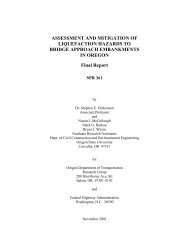Oregon Balance of State HIV/AIDS Housing & Services Systems ...
Oregon Balance of State HIV/AIDS Housing & Services Systems ...
Oregon Balance of State HIV/AIDS Housing & Services Systems ...
Create successful ePaper yourself
Turn your PDF publications into a flip-book with our unique Google optimized e-Paper software.
<strong>Oregon</strong> <strong>HIV</strong>/<strong>AIDS</strong> <strong>Housing</strong> and <strong>Services</strong> <strong>Systems</strong> Integration Plan 21<br />
<strong>Oregon</strong> is represented by the <strong>Oregon</strong> Health Care Association (OHCA), among other associations. 56<br />
OHCA provides training in venues that include an annual fall convention and spring expo.<br />
One alternative approach to long-term hospitalization is to provide services to clients in their own<br />
homes. Funding for these services is limited, yet this approach may be an appropriate option for<br />
some clients. For example, Our House <strong>of</strong> Portland operates a program providing in-home care (such<br />
as nursing, social work, and occupational therapy) to people living with <strong>HIV</strong>/<strong>AIDS</strong> in the Portland<br />
Eligible Metropolitan Area. Because many funding streams do not allow this type <strong>of</strong> service, the<br />
agency must fundraise creatively to support its programs. For more information on this and other<br />
innovative agencies, please see Appendix 1: Affordable <strong>Housing</strong> Resource Guide.<br />
Affordable <strong>Housing</strong> Resources<br />
In the survey <strong>of</strong> <strong>HIV</strong>/<strong>AIDS</strong> service agencies in <strong>Oregon</strong>, the lack <strong>of</strong> affordable housing was the<br />
number-one barrier to stability for people living with <strong>HIV</strong>/<strong>AIDS</strong>, identified by all 16 respondents.<br />
Of all respondents (<strong>HIV</strong>/<strong>AIDS</strong> agencies and non-<strong>HIV</strong>/<strong>AIDS</strong> agencies), 78 percent responded that<br />
creating more housing opportunities for people living with <strong>HIV</strong>/<strong>AIDS</strong> was a high priority for<br />
systems integration in the balance <strong>of</strong> state.<br />
In October 2006, <strong>Oregon</strong> <strong>Housing</strong> and Community <strong>Services</strong> (OHCS) published an inventory <strong>of</strong><br />
housing units that are dedicated as affordable across the state. OHCS reported 54,522 units <strong>of</strong><br />
affordable housing statewide, including 23,881 units in the balance <strong>of</strong> state, or 44 percent <strong>of</strong> the<br />
total. The population <strong>of</strong> the balance <strong>of</strong> state is 54 percent <strong>of</strong> the total <strong>Oregon</strong> population. 57<br />
Developing new affordable housing resources usually requires accessing funding sources from<br />
multiple levels <strong>of</strong> government. The following sections describe the main sources <strong>of</strong> affordable<br />
housing funding in <strong>Oregon</strong> and the planning processes that determine funding priorities. Affordable<br />
housing resources include federal and state program funds allocated through the state Consolidated<br />
Plan and Consolidated Funding Cycle and local Consolidated Plans, Low Income <strong>Housing</strong> Tax<br />
Credits, public housing authority resources, and the network <strong>of</strong> affordable housing developers in<br />
<strong>Oregon</strong>. The Continuum <strong>of</strong> Care planning process is discussed in the following section on homeless<br />
services, as it funds both services and housing targeted at reducing homelessness.<br />
The <strong>Oregon</strong> <strong>State</strong> Consolidated Plan and Consolidated Funding Cycle<br />
Consolidated Plans (Con Plans) are comprehensive planning documents required by the U.S.<br />
Department <strong>of</strong> <strong>Housing</strong> and Urban Development (HUD) for all states, large cities, and urban<br />
counties that receive Community Development Block Grant (CDBG), Emergency Shelter Grants<br />
(ESG), HOME Investment Partnerships Program (HOME), and/or <strong>Housing</strong> Opportunities for<br />
Persons with <strong>AIDS</strong> (HOPWA) funding. Of these, CDBG, HOME, and HOPWA can all support<br />
development activities. This planning process is intended to help local jurisdictions receive public<br />
input, develop a vision for housing and community development, and coordinate their activities.<br />
Con Plans are generally submitted on a five-year cycle, with annual action plans to describe<br />
activities expected in the coming year.<br />
56 <strong>Oregon</strong> Health Care Association website. Available online: http://www.ohca.com/ (Accessed: January 14, 2008).<br />
57 <strong>Oregon</strong> <strong>Housing</strong> and Community <strong>Services</strong>. Low Income <strong>Housing</strong> <strong>State</strong>-wide List. Available online: http://www.ohcs.oregon.gov/<br />
(Accessed: November 28, 2007).

















